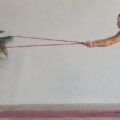Bear crawls are a dynamic, full-body exercise that challenge your muscles and cardiovascular system. They primarily target your shoulders and core, but also engage your legs and glutes. This exercise can be a game-changer for anyone looking to enhance their strength, endurance, and coordination. In this article, we’ll explore how to perform bear crawls correctly and why they should be a staple in your workout routine.
What Are Bear Crawls?
Bear crawls are a functional movement exercise that mimic the way a bear moves on all fours. This exercise is performed by maintaining a quadruped position with your knees off the ground, and ‘crawling’ forward and backward. This movement pattern engages multiple muscle groups and requires a combination of strength, stability, and agility.
Benefits of Bear Crawls
- Strengthen Core: Bear crawls intensely work your core muscles, including your abs and lower back, improving overall stability and strength.
- Enhance Shoulder Stability: Your shoulders are actively engaged to stabilize your body as you move, helping to build strength and endurance in the shoulder girdle.
- Boost Cardiovascular Fitness: Performing bear crawls at a steady pace can increase your heart rate and provide a cardiovascular challenge.
- Improve Coordination: This exercise requires coordination and proprioception, as you move your opposite arm and leg simultaneously.
How to Perform a Bear Crawl
Follow these steps to ensure you’re performing bear crawls correctly:
- Start on all fours with your hands under your shoulders and knees under your hips.
- Lift your knees slightly off the ground.
- Move your right hand and left foot forward at the same time, then alternate with your left hand and right foot.
- Keep your back flat and hips stable throughout the movement.
- Continue crawling forward for a set distance or time, then reverse the movement to return to the starting point.
Incorporating Bear Crawls into Your Workout
Bear crawls can be integrated into your workout routine in various ways. They can serve as a dynamic warm-up to prime your muscles or as a high-intensity interval within a circuit. Additionally, you can modify the exercise’s intensity by altering your speed or adding resistance with a weighted vest.
Common Mistakes to Avoid
When performing bear crawls, avoid these common mistakes to prevent injury and maximize effectiveness:
- Raising your hips too high, which can reduce core engagement.
- Letting your lower back sag, which can strain your spine.
- Moving your limbs out of sync, which can disrupt balance and coordination.
FAQ About Bear Crawl Exercise
Is the bear crawl exercise good for abs?
Yes, bear crawls are excellent for targeting the abs and the entire core region due to the need for stability and control during the movement.
How often should I do bear crawls?
Depending on your fitness level and goals, bear crawls can be done 2-3 times a week as part of a balanced workout routine.
Can bear crawls help with weight loss?
While bear crawls can contribute to a calorie-burning workout, weight loss is best achieved through a combination of diet and exercise.
Are there any variations of the bear crawl exercise?
Yes, there are several variations, such as the lateral bear crawl, reverse bear crawl, and bear crawl with push-ups, to challenge different muscle groups.
What muscles does the bear crawl exercise work?
The bear crawl works a variety of muscles including the shoulders, chest, arms, core, glutes, and legs.









